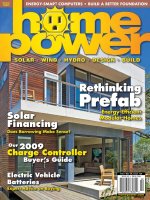ODS modal case histories 02 2009
Bạn đang xem bản rút gọn của tài liệu. Xem và tải ngay bản đầy đủ của tài liệu tại đây (2.21 MB, 47 trang )
ODS & Modal Case Histories
Barry T. Cease
Cease Industrial Consulting
February 20th, 2009
1
ODS & MODAL CASE HISTORIES
BARRY T. CEASE, CEASE INDUSTRIAL CONSULTING
FEBRUARY 20TH, 2009
INTRODUCTION
What is ODS analysis and why do we need it?
What is Modal analysis and why do we need it?
When should either technique be used?
Example of how to collect ODS & Modal data (test unit)
CASE HISTORY#1 – ACCEPTANCE TESTING OF AHU FAN
Equipment & problem description
Route data, coastdown data & determination of “offending frequencies”
Modal analysis of fan, motor & base
Conclusions & recommendations
CASE HISTORY#2 – ACCEPTANCE TESTING OF WATER PUMP
Equipment & problem description
Route data results versus standards & determination of “offending frequencies”
ODS analysis of pump, step 1 (baseline)
ODS analysis of pump, step 2
ODS analysis of pump, step 3
Conclusions & recommendations
QUESTIONS & CREDITS
“Modal Testing”, Robert J. Sayer, PE, Vibration Institute 31st Annual Meeting, June 19th, 2007
“Applied Modal & ODS Analysis”, James E. Berry, PE, 2004
“Machinery Vibration Analysis 3, Volume 2”, Vibration Institute, 1995
“Mechanical Vibrations, 2nd Edition”, Singiresu S. Rao, 1990
2
What Is ODS?
•
•
•
•
•
ODS stands for operating deflection shape.
ODS analysis generates a computer model of your machinery that depicts its motion
while running at operating speed & load. You literally “see” how your machine is
moving as it operates. This modeling can be extremely useful to illuminate an
otherwise elusive solution to machinery vibration problems.
First, a CAD model of the machine or mechanical system is created (structure file).
Second, detailed & meticulous vibration measurements are made on the machine
typically during normal operation. These measurements consist of both the amplitude
& phase of vibration at one or multiple frequencies of interest all referenced to a
common point.
Finally, these field measurements are imposed on the model to generate visible
animations of the model/machine at the distinct vibration frequencies of interest
(typically the “offending frequencies”).
3
What Is Modal Analysis?
•
•
•
•
Modal analysis identifies the frequencies & shapes your machine “likes to vibrate at”
(natural frequencies) and compares these to the normal forces present on the machine
to see if a match exists that produces an undesirable resonant condition.
If a resonant condition is identified, common solutions involve the following: force
reduction (ie: reducing the vibration forces present in the machine), tuning of the
mechanical system (ie: adding or reducing mass or stiffness to the system at the right
spots), or force “movement” (ie: changing the machine speed as possible to avoid the
condition).
The actual process of modal analysis is similar to that of ODS analysis except
measurements are made while the machine is not running typically using a force
hammer and one or more sensors. The hammer provides the input (force) and the
sensor(s) measure the response (motion) at multiple points on the machine.
These modal measurements are then processed thru a technique known as curve-fitting
and then like ODS measurements, imposed on the model to produce animations that
are analyzed.
4
Vibration Spectra .vs. Modal Data
PLOT 1: Vibration data measured during normal operation. Dominant vibration at 1,789 cpm or 1x RPM of
machine (“offending frequency”).
PLOT 2: Modal data measured while machine down. Note the strong response at 1,837 cpm which is near 1x RPM.
5
When Should ODS or Modal Analysis Be Used?
•
•
•
When standard vibration analysis techniques have failed to determine the exact
problem.
When resonance is suspected.
An ODS or Modal job begins best with a determination of the “offending frequencies of
vibration” usually made using standard, route vibration spectra.
6
Example: Collecting ODS Data From
CMS Test Rotor Kit
•
•
•
•
•
Machine operating.
Determine reference point (typically use route data point with strong vibration at all
“offending frequencies”).
First roving point collected at reference point (ie: 1Y:1Y).
Continue collecting other points all along machine at predetermined points.
Both the total number of points collected as well as the point locations are key to how
accurate the model animation will represent reality (ie: spatial aliasing).
7
Example: Collecting Modal Data From
CMS Test Rotor Kit
•
•
•
•
•
•
Machine not operating.
Determine reference (driving) point. Like ODS analysis above, we want to use a point
with strong vibration at all “offending frequencies”, but for modal analysis, we must be
even more “picky” by applying the impact & measuring the response at many points
until good representation of all offending frequencies is found (“driving point”).
First roving point collected at driving point (ie: 1Y:1Y).
Usually, we rove around with the sensor(s) and apply impact at the driving point, but
this isn’t necessary. We could also rove around with the hammer with similar results
although getting a good impact at all points is typically difficult.
Continue collecting other points all along machine at predetermined points.
Like ODS analysis, both the total number of points collected as well as the point
locations are key to how accurate the model animation will represent reality (ie: spatial
aliasing).
8
Case History#1: Acceptance Testing Of AHU Fan
Equipment & Problem Description
•
•
•
•
•
•
Newly installed AHU Fan operating at
medical facility.
Vibration acceptance testing required
for all rotating equipment at facility.
Fan OEM contacted for vibration
specifications - maximum acceptable
vibration at 0.35 ips-pk.
Isolated, center-hung, centrifugal fan
driven thru v-belts by a 4-pole
induction motor operating on a variable
speed drive.
Entire machine supported by 4-ea
spring isolators mounted on floor
arranged per diagram at right.
Two spring isolators are also mounted
between the fan frame and wall to
counter fan thrust.
4-ea Floor
Isolators
2-ea Wall
Isolators
Fan
Motor
9
INITIAL DATA & FINDINGS, PART 1
•
•
•
•
•
•
Initial vibration data was collected on both
fan & motor at 100% speed and overall levels
were compared to OEM specifications.
Because this machine operated on a variable
speed drive with normal operation anywhere
between 50 and 100% full speed, coastdown
data was collected between this speed
range.
Unfortunately, this machine failed to stay
within OEM specs both at 100% speed and at
many points between 50 & 100% speed.
Maximum vibration levels occurred not at
100% speed, but at lower speeds suggesting
possible resonance problems.
“Offending speeds/frequencies” were
identified from coastdown data at
approximately 1,500, 1,800 & 1,900 cpm.
Field observations noted the entire machine
visibly “jumped” when the machine speed
was set to 90-95% and motion at the motor
outboard isolator seemed worst.
Vibration @
100% Speed
Maximum
Vibration
Level
Fan Speed @
Max Vibration
OEM
Vibration
Spec
Motor, Outboard,
Horizontal
1.289
n/a
n/a
0.35
Motor, Outboard -
Vertical
1.475
n/a
n/a
0.35
Motor, Inboard -
Horizontal
0.955
n/a
n/a
0.35
Motor, Inboard - Vertical
1.027
n/a
n/a
0.35
Motor, Inboard - Axial
1.205
n/a
n/a
0.35
Fan, Inboard -
Horizontal
1.929
3.11
1,903
0.35
Fan, Inboard - Vertical
0.605
0.45
1,495
0.35
Fan, Inboard - Axial
0.257
n/a
n/a
0.35
Fan, Outboard -
Horizontal
0.797
2.60
1,492
0.35
Fan, Outboard - Vertical
0.672
0.65
1,805
0.35
Fan, Outboard - Axial
0.258
n/a
n/a
0.35
Measurement Point
10
INITIAL DATA & FINDINGS, PART 2
AHU SF1.3 MOTOR & FAN, OVERALL VIBRATION AT FULL SPEED
O V E R A L L V IB R A T IO N (IP S -P K )
2.5
2
1.5
1
0.5
0
MOH
MOV
MIH
MIV
MIA
FIH
FIV
FIA
FOH
FOV
FOA
MEASUREMENT POINT
Plot of overall vibration levels at all measurement points at full speed.
11
SPECTRAL DATA AT FULL SPEED
SF-1.3
Cursor A:
1987.5 CPM
1.821 in/s
O/All 1.938 in/s 0-pk
1.4
Motor, Outboard
Horizontal
Vel Spec 60000 CPM
12/27/2007 4:33:35 PM
O/All 1.276 in/s 0-pk
<set RPM>
0
1.4
Motor, Outboard
Vertical
Vel Spec 60000 CPM
12/27/2007 4:34:40 PM
O/All 1.363 in/s 0-pk
<set RPM>
0
1.4
Fan, Inboard
Horizontal
Vel Spec 60000 CPM
12/27/2007 4:42:59 PM
O/All 1.938 in/s 0-pk
<set RPM>
0
2
1.8
1.6
in/s 0-pk
1.4
1.2
Fan, Outboard
Horizontal
Vel Spec 60000 CPM
12/27/2007 4:45:23 PM
1
0.8
0.6
0.4
O/All 0.772 in/s 0-pk
<set RPM>
0.2
0
0
2,000
4,000
6,000
8,000
10,000
12,000
14,000
16,000
18,000
20,000
22,000
24,000
26,000
28,000
30,000
CPM
Spectral data from points of high vibration at full speed (MOH, MOV, FIH & FOH). Dominant
vibration in all spectra occurs at top fan speed of 1,987 cpm or 33.1 Hz.
12
FAN COASTDOWN DATA, BODE PLOTS
Bode Plot - 1X - SF-1.3 - Fan, Inboard - Horizontal
Vel Freq 30000 CPM [Tach]
Bode Plot - 1X - SF-1.3 - Fan, Outboard - Horizontal
Vel Freq 30000 CPM [Tach]
3.108 in/s 0-pk, 55.506 deg @ 1903.091 CPM (1903 RPM)
80
80
60
60
40
40
20
deg
deg
2.6 in/s 0-pk, 31.233 deg @ 1496.278 CPM (1492 RPM)
100
20
0
0
-20
-20
-40
-40
-60
-60
800
1,000
1,200
1,400
1,600
1,800
2,000
800
1,000
1,200
CPM
1,400
1,600
1,800
2,000
1,400
1,600
1,800
2,000
CPM
2.6
3
2.4
2.2
2.5
2
1.8
2
in/s 0-pk
in/s 0-pk
1.6
1.5
1.4
1.2
1
1
0.8
0.6
0.5
0.4
0.2
0
0
800
1,000
1,200
1,400
1,600
1,800
2,000
800
CPM
Vel Freq 30000 CPM [Tach]
PLOT 14: Coastdown data at fan, inboard, horizontal
(FIH) position in Bode format shows suspected natural
frequency at approximately 1,900 cpm (31.667 Hz). The
highest vibration level on the fan was measured at this
point at 1,903 rpm at 3.11 ips-pk!!
1,000
1,200
CPM
Vel Freq 30000 CPM [Tach]
PLOT 15: Coastdown data at fan, outboard, horizontal
(FOH) position in Bode format shows suspected natural
frequency at approximately 1,500 cpm (25 Hz). The
highest vibration level measured at this point occurred at
1,495 rpm at 2.60 ips-pk!!
13
INTERFERENCE DATA (MOTOR & FAN SPEEDS)
% Full Speed
Fan RPM
1x Fan
2x Fan
1x Motor
2x Motor
fn1
fn2
fn3
25
500
500
999
446
892
1,500
1,800
1,900
30
599
599
1,199
535
1,070
1,500
1,800
1,900
35
699
699
1,399
624
1,249
1,500
1,800
1,900
40
799
799
1,598
714
1,427
1,500
1,800
1,900
45
899
899
1,798
803
1,606
1,500
1,800
1,900
50
999
999
1,998
892
1,784
1,500
1,800
1,900
55
1,099
1,099
2,198
981
1,962
1,500
1,800
1,900
60
1,199
1,199
2,398
1,070
2,141
1,500
1,800
1,900
65
1,299
1,299
2,597
1,160
2,319
1,500
1,800
1,900
70
1,399
1,399
2,797
1,249
2,498
1,500
1,800
1,900
75
1,499
1,499
2,997
1,338
2,676
1,500
1,800
1,900
80
1,598
1,598
3,197
1,427
2,854
1,500
1,800
1,900
85
1,698
1,698
3,397
1,516
3,033
1,500
1,800
1,900
90
1,798
1,798
3,596
1,606
3,211
1,500
1,800
1,900
95
1,898
1,898
3,796
1,695
3,390
1,500
1,800
1,900
100
1,998
1,998
3,996
1,784
3,568
1,500
1,800
1,900
Interference data table. Forcing frequencies .vs. suspected natural frequencies.
14
INTERFERENCE DIAGRAM
Interference diagram of fan & motor speeds .vs. suspected natural frequencies at 1,500, 1,800 & 1,900 cpm.
Potential interference occurs at approximately 750, 850, 900, 950, 1000, 1075, 1,500, 1675, 1,800, 1,900 & 2,000 rpm.
15
MODAL ANALYSIS OF AHU FAN
•
•
•
•
•
A Simple CAD model of the fan,
motor & base was created and
modal data collected.
This modal data was imposed on
the model appropriately to identify
the natural frequencies of the
mechanical system.
The known offending frequencies
were compared with natural
frequencies found to identify a
match that would result in
resonance condition.
Two natural frequencies (modes)
were identified which most likely
are being excited by the fan speeds
as: 26.1 & 31.1 Hz or 1,566 &
1,866 cpm.
Both these modes involve
distortion of the machine base
near the motor.
Simple CAD Model of AHU fan.
16
MODAL ANALYSIS – 26.1 Hz Mode
Modal animation at 26.1 Hz of AHU fan & motor
inboard. Note distortion of machine frame near
motor.
Modal animation at 26.1 Hz of AHU fan & motor
outboard. Note distortion of machine frame near
motor.
17
MODAL ANALYSIS – 31.1 Hz Mode
Modal animation at 31.1 Hz of AHU fan & motor
inboard. Note distortion of machine frame near motor.
Modal animation at 31.1 Hz of AHU fan & motor
outboard. Note distortion of machine frame near motor.
18
CONCLUSIONS & RECOMMENDATIONS, AHU FAN
1) This fan failed OEM vibration specifications due primarily to resonances identified in the
machine frame at 26.1 & 31.1 Hz.
2) Unbalance may exist in the fan, but it’s contribution is minor by comparison to the
resonances identified. If balancing is done to reduce forces, perform at 1,200 rpm fan
speed or lower to avoid resonances and associated balance difficulties.
3) The isolator near the motor outboard may be loose with the floor. Please inspect &
repair as needed.
4) Resolving the resonance issues will likely involve either adding an additional pair of
isolators between the fan & motor or stiffening the machine frame near the motor or
both.
5) Stiffening the machine frame might be accomplished by welding either “X” bracing
inside the base near the motor or welding plate onto the machine frame for the motor
base to rest on.
6) A slightly larger AHU fan of similar design with six isolators instead of four was also
tested as part of this job – this six isolator fan passed acceptance testing at all speeds.
7) These conclusions were presented to the customer along with documentation. Months
later I checked with plant personnel who informed me my customer had opted to
balance the fan with disappointing results.
19
CASE HISTORY#2 - ACCEPTANCE TESTING OF HIGH
PRESSURE WATER PUMP
Equipment & Problem Description
•
•
•
•
Newly installed critical high pressure
water pump at plant.
Plant vibration specs called for maximum
vibration levels of 0.10 ips-pk.
At first glance, many problems were
seen with the design & layout of the
pump & piping.
What follows are vibration spectral &
ods data at progressive stages of our
attempt to bring this pump into plant
specs.
Initial state of newly installed water pump. What
is wrong with this design & layout?
20
BASELINE OVERALL LEVELS 9/16/08
•
•
•
•
Plant vibration specs called for overall levels no greater than 0.10 ips-pk.
Both the motor & pump failed specs during baseline measurements taken on 9/16.
Highest levels were seen at pump with much higher than expected thrust levels.
Movement could be felt at the floor while collecting data.
21
BASELINE SPECTRA 9/16/08
•
•
•
•
Pump spectra from 9/16/08 shows dominant vibration at the vane-pass frequency (4x rpm) of the pump.
A higher than normal vibration level at this frequency generally indicates flow problems of some sort with
the pump. From the photo earlier, what did you see that could be causing flow problems at this pump?
Horizontal measurement shows high 1x & 2x rpm vibration as well as vane-pass.
Thus, our offending vibration frequencies are primarily 1x, 2x & 4x rpm for this machine on 9/16/08
(baseline).
22
BASELINE ODS 9/18/08 – MOTION @ 1xRPM (3,590 cpm)
•
•
•
Pump maximum vibration at this
frequency occurred at the pump,
inboard, horizontal measurement
(PIH) at 0.05 ips-pk.
Note 180 degree radial motion
across the coupling at this key
frequency. Shaft alignment & soft
foot are suspect.
Note movement of both machine
pedestal & surrounding floor
suggesting significant problems
with this machine foundation.
23
BASELINE ODS 9/18/08 – MOTION @ 2xRPM (7,180 cpm)
•
•
Pump maximum vibration at this
frequency occurred at the pump,
inboard, horizontal measurement
(PIH) at 0.08 ips-pk.
Note vertical movement of entire
pedestal & surrounding floor at
this frequency (120 Hz) again
suggesting significant problems
exist with this machine foundation.
24
BASELINE ODS 9/18/08 – MOTION @ 4xRPM (14,400 cpm)
•
•
•
•
Pump maximum vibration at this
frequency occurred at the pump,
inboard, vertical measurement
(PIV) at 0.24 ips-pk.
Note thrusting of both pump
suction area and entire pump
rotor. I suspect this is due in part
to turbulence at the pump suction
from “elbow entry”.
Note continued pedestal &
foundation movement.
Note little movement at motor.
25









